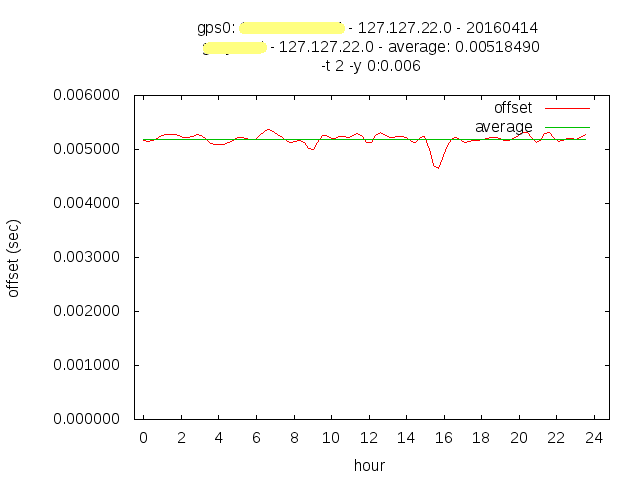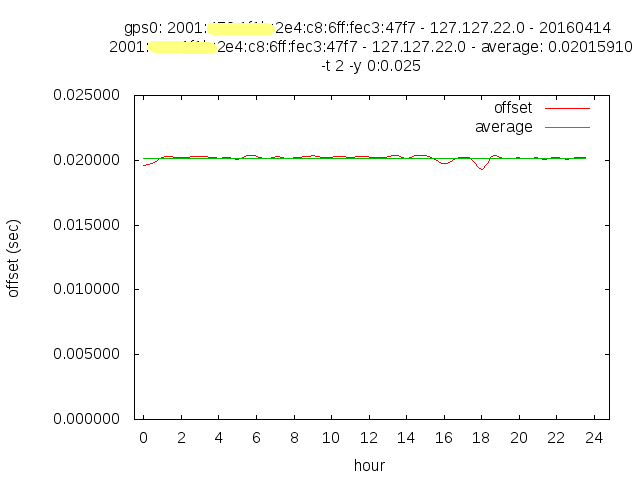NTP and ADSL - a study
At home I am connected to the Internet via ADSL. Up-link speed is 768 kbit/sec and download speed is 8 Mbit/sec. Therefore an NTP frame with 90 bytes or 720 bits needs 937.5 μs going to the Internet and 90 μs coming from the Internet. Reading NTP documentation it says the protocol assumes a symmetric situation for both directions. I was always wondering how precisely NTP could be at home. To verify this I prepared a stratum 1 server. It consists of a Banana Pi with a GPS module from M0UPU. The 1PPS is feed to the GPIO and “ntpd” is using this signal directly. The time information is read via SHMEM over “gpsd”.
I installed this NTP server in a network which is connected with 1 Gbit/sec in both directions ( upload and download ) to the backbone of Vienna’s Internet. In “ntp.conf” I configured a stratum 1 server as reference with keyword “noselect”. The typical round-trip-time to this server is 4.5 ms.
Below you see a graph with the offset over a day (20160313). The average offset is 22.57 μs. Probably this could be adjusted but I don’t care about this.

Now I took this server at home connecting to the LAN and via ADSL to the Internet. I run the server for more than a day (20160315) and the average offset is now 5.076 ms or 5076 μs. If we take this 22 μs from before it is still 5054 μs.

You can also see jitter is much more than in the Gigabit LAN. Also round-trip-time is more than 21 ms. And of course my local server “believes” that the remote stratum 1 server is 5 milliseconds behind and we are 5 ms ahead.
# ntpq -pn
remote refid st t when poll reach delay offset jitter
==============================================================================
o127.127.22.0 .PPS. 0 l 5 16 377 0.000 0.004 0.010
*127.127.28.0 .GPS. 0 l 4 16 377 0.000 -1.191 1.096
XXX.XXX.127.149 .ATOM. 1 u 161 256 377 21.342 -5.066 12.087
And what is the practical significance ?
If somebody is using NTP as a client in a network with ADSL connectivity it is always 5 ms behind the reference. Not important, but good to know. Of course this 5 ms happens only with a similar ADSL line I have. See this blog at the top.
And the other way around
This is the situation where the NTP server is located behind an ADSL line and the query is done from the Internet.
Below you can see two different destinations.
Delay 20 ms
The first one show a remote server with around 20 ms round trip delay. This is typical for an ADSL line like described above.

Here one can see that the server seems to be ahead about 5.2 ms.

Actually this result is not surprising now.
# ntpq -pn
remote refid st t when poll reach delay offset jitter
==============================================================================
o127.127.22.0 .PPS. 0 l 2 16 377 0.000 -0.004 0.002
*127.127.28.0 .GPS. 0 l 12 16 377 0.000 2.732 0.763
XXX.XX.75.134 .PPS. 1 u 37 64 377 19.758 5.114 1.021
Delay 65 ms
The second server is reachable through an IPv6 tunnel which generates a round-trip time of about 65 ms. This IPv6-in-IPv4 tunnel goes over an ADSL line too.

We can see an average offset of 20 ms.

# ntpq -pn
remote refid st t when poll reach delay offset jitter
==============================================================================
o127.127.22.0 .PPS. 0 l 2 16 377 0.000 -0.004 0.002
*127.127.28.0 .GPS. 0 l 12 16 377 0.000 2.732 0.763
2001:XXX:XXXX:2 .PPS. 1 u 34 64 377 65.190 20.147 1.548
For theoretical explanations and mathematical examples about NTP over ADSL see my other blog here.
See also: NTP Timestamp Calculations